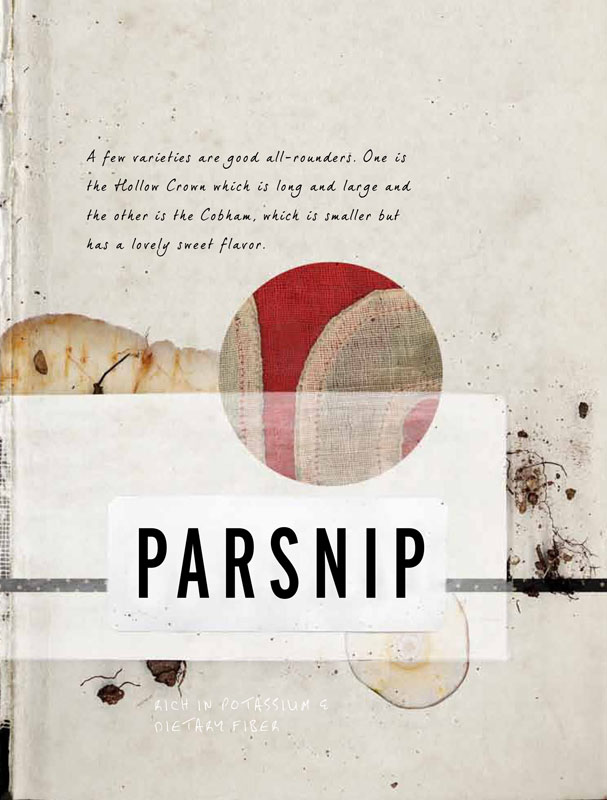
Parsnips are very similar to carrots to grow and use. They love the same style of soil, enjoy the same methods of cooking and, in fact, the word parsnip was once interchangeable with carrot in Europe. Combine this with the popularity of the white carrot variety at the time and you can see how it would have been easy to confuse the two. The main difference between them is that parsnip has a much earthier flavor and the texture is much more fibrous.
RECIPES
PARSNIP & BLACK RICE RISOTTOWITH OR WITHOUT LOBSTER
Parsnips will grow all year round, but like carrot and beets, they can bolt to seed and become woody in summer. They do well in winter, but the cold will tend to slow their growth. They are really at their best in autumn and spring. Parsnips are not the easiest plant to grow first time around, especially from seed, but once you get a few crops you’ll get the hang of it. The trick is, once planted, pat down the soil and keep the whole area really moist for three to four days after. Parsnips are frost tolerant, in fact, frost will improve their flavor, but they like to be kept moist. From seed to harvest should be four to five months.
There are a few varieties I know of which are good all-rounders and relatively easy to grow, provided you have a nice sandy soil. One is the Hollow Crown, which is a quite long, large variety, and the other is the Cobham, which is relatively smaller but has a lovely sweet flavor. Parsnip varieties can be divided into three groupings based on shape. These are bulbous (or round), bayonet and wedge. The bayonet is fairly straight up and down. The wedge is the type that most of us will recognize, with its broad shoulders and tapered waist. They can vary slightly in color but really only from a creamy white color to a yellow-white. The main difference will be length, width, and, of course, flavor. So try a few different ones and decide for yourself which type you prefer.
The modern parsnip that we recognize today is the offspring of the wild parsnip, which can still be found growing on roadsides and in fields all over Europe. It’s pretty thin and spindly looking. Not much chop really when compared to the lovely fat parsnips of today. It is thought that the Romans were the first to properly cultivate the parsnip. It is a member of the Umbelliferae (also called Apiaceae) family, which is a group of hollow-stemmed, aromatic plants that include the likes of parsley, chervil and of course, my favorites, carrots.
The parsnip waned in popularity in France, where instead they fed it to their pigs. Parsnip-fed pig was thought to be a very fine delicacy. This practice is still used in Italy to raise pigs for prosciutto. Parsnip is also used as a flavoring in some Irish beers.
When cooking them, I find you will have a better result if you steam parsnips rather than boil them because of their naturally high starch content. They can go quite gluggy if boiled, which is not very desirable. Also, because of their high sugar content, parsnips roast extremely well. Just peel the outside skin and cut into quarters lengthways. I always remove the core, as it is very astringent and quite indigestible (apart from those in very young parsnips). Then just toss them in a bit of oil and seasoning and roast. Delicious. Or try roasted parsnips with a honey glaze—it is an absolute classic and one of my favorite vegetable side dishes. I didn’t include a recipe for it, as I figured everyone is probably already familiar with it or have their mom’s recipe, but if you’re not or you don’t, don’t worry. It is very easy to make. Just put your parsnips in a flameproof roasting tray on the stovetop and cook until you get a nice bit of color on them. Then deglaze the pan with some honey and a little bit of nice vinegar, like a white wine or chardonnay. Put the pan straight into a hot oven and roast until lovely and tender. That’s it. Then into a bowl and onto the table. Yum!

PARSNIP & BLACK RICE RISOTTO WITH OR WITHOUT LOBSTER
SERVES 6
Parsnip adds a wonderful rich, earthy flavor, especially when combined with sweet mascarpone and seafood. Although I have written this “with or without lobster” give it a try “with” for me. Parsnip is often overlooked as an accompaniment for seafood, but it binds really well, adding a real richness.
5 LARGE PARSNIPS
3½ TABLESPOONS BUTTER
3 TABLESPOONS OLIVE OIL
⅔ CUP MASCARPONE
3½ OUNCES HORSERADISH PURÉE (FROM A JAR)
⅓ CUP OLIVE OIL
2 CUPS BLACK ARBORIO RICE (SEE NOTE)
⅓ CUP WHITE WINE
8 OUNCES COOKED LOBSTER MEAT
1 CUP CHOPPED DILL AND CHERVIL
JUICE OF 2 LEMONS
SEA SALT AND FRESHLY GROUND BLACK PEPPER
For the purée, top, tail, peel and core the parsnips, keeping all the scraps. Place the scraps and 6 cups of water in a saucepan and bring to a boil, then simmer for 15 minutes. Set the broth aside and return to a simmer when ready to make the risotto. (This is an excellent broth for all vegetarian dishes.)
Meanwhile, thinly slice the peeled parsnips. Heat a large skillet, add the butter and olive oil over low heat, add the parsnip and sweat for 2–3 minutes. Turn up the heat, add 1¼ cups of water, bring to a boil and cook for 7–9 minutes or until the parsnip is tender. Strain, reserving the cooking juices. Blitz the cooked parsnip in a food processor with the mascarpone and horseradish purée until smooth. If necessary, add a little of the reserved juices to thin out the blitzed purée to the consistency of mashed potato.
For the risotto, heat a large heavy-bottomed skillet heat over medium heat, add the olive oil and heat for 1 minute. Add the rice, stir to coat and cook for 2–3 minutes or until coated. Add the wine and cook out for 3–5 minutes or until evaporated. Gradually add the hot broth, 1 cup at a time, stirring frequently, allowing each addition to be absorbed before adding the next, until the rice has absorbed all the broth and is cooked. Take off the heat, fold in the parsnip purée, then return to the heat. To finish, stir through the lobster, herbs and lemon juice and season with salt and pepper.
Note Why black Arborio rice? For me, the nuttier flavor of the black rice gives the parsnip an extra kick. If you can’t find black Arborio rice, regular white Arborio rice is fine but it will not need as much cooking.
MAKES ROUGHLY THE SAME AMOUNT AS FOUND IN A GOOD-SIZED BAG OF POTATO CHIPS
This is such a delicious snack that it makes its bought potato counterpart look like one of Cinderella’s stepsisters. These beauties are an awesome quick snack, great with a beer watching football, as a canapé or even as an alternative to potato chips for the kids’ dinners. They’re fun to make with the kids too. Don’t be scared to fry in the home. Yes, you need a deep-fryer and yes, of course, they are fried, but they taste delicious. As long as you have a thermometer and your oil doesn’t heat to above 400°F, you should be fine. Obviously, you need to observe this task very closely. Try making chips from other root vegetables such as carrot, sweet potato and even lotus root, but my favorite is the parsnip. The chippies will stay crispy for about 6 hours if you would like to pre-fry them as a snack before a dinner party.
4 CUPS VEGETABLE OR SUNFLOWER OIL, FOR DEEP-FRYING
1 REGULAR OR 2 SMALL PARSNIPS (ABOUT 10½ OUNCES IN TOTAL)
SEA SALT OR HERB SALT (SEE RECIPE)
Heat the oil in a deep-fryer to 315°F or in a deep saucepan (no more than one-third full). Peel the parsnip and top and tail, then make wafer-thin slices either on a mandoline or simply peel into slices using long strokes.
Place a frying basket into the hot oil, add a handful of parsnip slices and cook for 30 seconds, then lift the basket. Leave for 1–2 minutes, then submerge again in the oil and fry until golden brown. This blanching step helps crispen up the parsnip. Tip the chips out onto a tray lined with paper towels to absorb the excess oil, and repeat with the remaining parsnip slices. Pour the drained chips into a bowl, sprinkle with the salt and enjoy with a nice cold beer.
MAKES ABOUT 2 CUPS
If herb salt was a lady it would be Rita Hayworth: timeless, elegant and beautifully tasty. This must become one of your kitchen pantry basics—on hand, all the time, to give that extra bit of finesse to a dish.
⅔ CUP VEGETABLE OIL
5⅔ OUNCES ROSEMARY, OREGANO AND SAGE LEAVES
⅔ CUP SEA SALT
Gently heat the oil in a shallow saucepan over medium heat to 325°F. Add the herbs and deep fry for 7–10 minutes or until crispy. Turn off the heat and scoop out the herbs onto a tray lined with lots of paper towels. Take the herbs off the towel and dry again on a tea towel. Place into a mortar with the salt and finely crush all together. Keep in an airtight container for up to 6 months and use just as you would any normal salt.
Note Ever wondered what to do with those left-over herbs like parsley and basil that are just withering at the bottom of your fridge. Hey presto, here you go. Just use them up to make this salt to avoid wasting them. When you use soft-leaved herbs gently fry them for a little less time, 3–4 minutes, say.
PARSNIP SKORDALIA
MAKES 2 CUPS
Such a simple yet pleasant recipe, this is my twist on the classic skordalia, usually made with potatoes. I love the sweet earthy flavor that the parsnip adds, not to mention the texture of the hazelnuts and garlic flavor rounding everything out at the end. It’s essential to remove the woody core of the parsnip or your purée will be stringy and I prefer to use skim milk as it helps prevent scorching.
¼ CUP HAZELNUTS (SEE NOTE)
3½ OUNCES ORGANIC GARLIC CLOVES, BLANCHED TWICE IN SALTED BOILING WATER
1 LARGE PARSNIP, PEELED, CORED AND THINLY SLICED (SEE NOTE)
1⅔ CUPS SKIM MILK
JUICE OF ½ LEMON
3 TABLESPOONS EXTRA VIRGIN OLIVE OIL
1 TABLESPOON FINELY CHOPPED ITALIAN PARSLEY
SEA SALT AND FRESHLY GROUND BLACK PEPPER
Preheat the oven to 350°F. Place the hazelnuts on a baking sheet and roast for 5–10 minutes. Place in a tea towel and rub off the skins while still warm.
Place the garlic, parsnip, hazelnuts and milk in a saucepan, bring to a boil, then reduce to a simmer and cook until the parsnip is tender. Pass through a fine strainer, reserving both the solids and cooking liquid. Pulse the parsnip mixture in a blender or use a hand-held stick blender until a chunky purée, adding a little of the reserved cooking liquid to achieve the consistency of a purée. Stir through the lemon juice, olive oil and parsley and season with salt and pepper to finish.
Note If you want to make a more traditional skordalia, replace the parsnip with potato and the roasted hazelnuts with blanched almonds (not roasted).